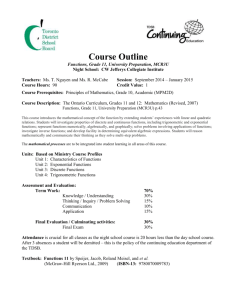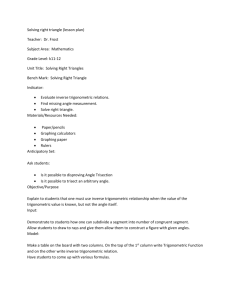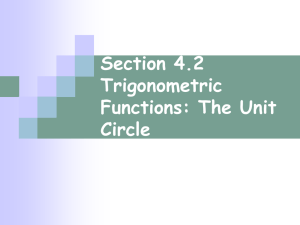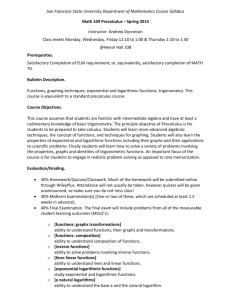MATH 1750 doc
advertisement
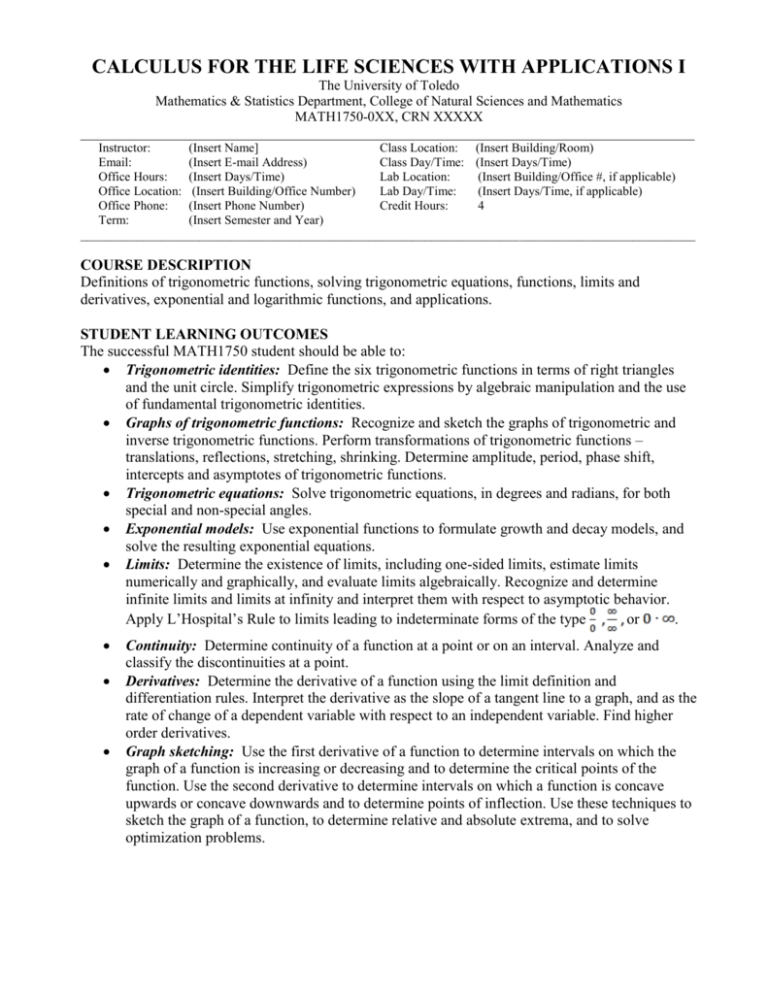
CALCULUS FOR THE LIFE SCIENCES WITH APPLICATIONS I The University of Toledo Mathematics & Statistics Department, College of Natural Sciences and Mathematics MATH1750-0XX, CRN XXXXX _________________________________________________________________________________________ Instructor: (Insert Name] Class Location: (Insert Building/Room) Email: (Insert E-mail Address) Class Day/Time: (Insert Days/Time) Office Hours: (Insert Days/Time) Lab Location: (Insert Building/Office #, if applicable) Office Location: (Insert Building/Office Number) Lab Day/Time: (Insert Days/Time, if applicable) Office Phone: (Insert Phone Number) Credit Hours: 4 Term: (Insert Semester and Year) __________________________________________________________________________________________________ COURSE DESCRIPTION Definitions of trigonometric functions, solving trigonometric equations, functions, limits and derivatives, exponential and logarithmic functions, and applications. STUDENT LEARNING OUTCOMES The successful MATH1750 student should be able to: Trigonometric identities: Define the six trigonometric functions in terms of right triangles and the unit circle. Simplify trigonometric expressions by algebraic manipulation and the use of fundamental trigonometric identities. Graphs of trigonometric functions: Recognize and sketch the graphs of trigonometric and inverse trigonometric functions. Perform transformations of trigonometric functions – translations, reflections, stretching, shrinking. Determine amplitude, period, phase shift, intercepts and asymptotes of trigonometric functions. Trigonometric equations: Solve trigonometric equations, in degrees and radians, for both special and non-special angles. Exponential models: Use exponential functions to formulate growth and decay models, and solve the resulting exponential equations. Limits: Determine the existence of limits, including one-sided limits, estimate limits numerically and graphically, and evaluate limits algebraically. Recognize and determine infinite limits and limits at infinity and interpret them with respect to asymptotic behavior. Apply L’Hospital’s Rule to limits leading to indeterminate forms of the type or . Continuity: Determine continuity of a function at a point or on an interval. Analyze and classify the discontinuities at a point. Derivatives: Determine the derivative of a function using the limit definition and differentiation rules. Interpret the derivative as the slope of a tangent line to a graph, and as the rate of change of a dependent variable with respect to an independent variable. Find higher order derivatives. Graph sketching: Use the first derivative of a function to determine intervals on which the graph of a function is increasing or decreasing and to determine the critical points of the function. Use the second derivative to determine intervals on which a function is concave upwards or concave downwards and to determine points of inflection. Use these techniques to sketch the graph of a function, to determine relative and absolute extrema, and to solve optimization problems. PREREQUISITES Passing grade in Math 1320 or sufficient score on the Math Placement Exam. TEXTBOOKS: Calculus for Biology and Medicine, Third Edition, by Claudia Neuhauser (ISBN: 9781256873778), and Schaum’s Outlines Trigonometry, Fifth Edition, by Moyer and Ayres (ISBN: 9780071543507) UNIVERSITY POLICIES: POLICY STATEMENT ON NON-DISCRIMINATION ON THE BASIS OF DISABILITY (ADA) The University is an equal opportunity educational institution. Please read The University's Policy Statement on Nondiscrimination on the Basis of Disability Americans with Disability Act Compliance. ACADEMIC ACCOMODATIONS The University of Toledo is committed to providing equal access to education for all students. If you have a documented disability or you believe you have a disability and would like information regarding academic accommodations/adjustments in this course please contact the Student Disability Services Office (Rocket Hall 1820; 419.530.4981; studentdisabilitysvs@utoledo.edu) as soon as possible for more information and/or to initiate the process for accessing academic accommodations. For the full policy see: http://www.utoledo.edu/offices/student-disability-services/sam/index.html ACADEMIC POLICIES: STUDENT PRIVACY Federal law and university policy prohibits instructors from discussing a student's grades or class performance with anyone outside of university faculty/staff without the student's written and signed consent. This includes parents and spouses. For details, see the “Confidentiality of student records (FERPA)” section of the University Policy Page at http://www.utoledo.edu/policies/academic/undergraduate/index.html MISSED CLASS POLICY If you miss any graded item, then this item may only be made up in accordance with the University’s Missed Class Policy. This policy requires that you contact me in advance by phone, e-mail or in person, provide official documentation for the absence, and make up the missed item as soon as possible. You can find the University’s Missed Class Policy at http://www.utoledo.edu/facsenate/missed_class_policy.html ACADEMIC DISHONESTY Any act of academic dishonesty as defined by the University of Toledo policy on academic dishonesty (found at http://www.utoledo.edu/dl/students/dishonesty.html) will result in an F in the course or an F on the item in question, subject to the determination of the instructor. GRADING AND EVALUATION The syllabus should describe the methods of evaluation whether quizzes, exams, or graded assignments. The usual procedure is to give at least two one-hour in class exams and a two-hour final exam. If quizzes are not used as a portion of the grade, then three one-hour exams are recommended. A description of a grading method that includes the proportion that each evaluating method counts toward the grade should be described. If the grading method uses a grading scale it should be clearly stated. It should be kept in mind when scheduling quizzes and exams that the last day to add/drop the class is the end of the second week of classes and the last day to withdraw from the class is the end of the tenth week. By these dates, students like to have some measure of their progress in the class. IMPORTANT DATES *The instructor reserves the right to change the content of the course material if he perceives a need due to postponement of class caused by inclement weather, instructor illness, etc., or due to the pace of the course. MIDTERM EXAM: FINAL EXAM: OTHER DATES The last day to drop this course is ________________ The last day to withdraw with a grade of “W” from this course is ___________________ STUDENT SUPPORT SERVICES Free math tutoring on a walk-in basis is available in the Math Learning and Resources Center located in Rm B0200 in the lower level of Carlson Library (phone ext 2176). The Center operates on a walk-in basis. MLRC hours can be found at http://www.math.utoledo.edu/mlrc/MLRC.pdf CLASS SCHEDULE Syllabus should provide a list of sections to be covered and it is advisable to give an exam and quiz schedule. A suggested course schedule is found below. Most instructors find the syllabus to be quite crowded, so the course needs to be well paced to avoid cramming too much material in at the end of the semester. Most students will enroll in MATH 1760 that has MATH 1750 as a prerequisite. SUGGESTED SCHEDULE FOR MATH 1750: Week 1 2 3 4 5 6 7 8 9 10 11 12 13 14 15 Subject Review of functions Foundations of Trigonometry Graphing Trig Functions Trigonometric Identities, (Exam) Trigonometric Equations, Exponential Models Limits Limits of Trig Functions, Continuity Definition of Derivative (Exam) Rules of Differentiation More Methods and Derivatives of Trig Functions Derivatives Exponential Functions and Inverse Functions Approximation, Extrema (Exam) Monotonicity, Convexity, Curve Sketching More Curve Sketching, Optimization More Optimization, L’Hospital’s Rule, Review Time Allocation: Chapter 1 2 Schaum’s 3 4 5 Exams, Review 4 Hours 4 1 15 7 17 12 Sections 1.1, 1.2, Schaum’s 1.1-1.5, 2.1-2.9, 3.1-3.7 Schaum’s 6.1-6.4, 7.1-7.6 Schaum’s 8.1-8.3, 9.1-9.4 Schaum’s 14.1-14.2, 2.1 3.1, 3.2, 3.3 3.4, 3.5, 4.1 4.1, 4.2 4.3, 4.4 4.4, 4.5 4.6, 4.7 4.8, 5.1 5.2, 5.3 5.3, 5.4 5.4, 5.5, Review


